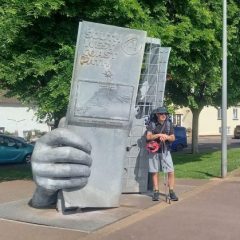Been over the Severn Bridge into south Wales to carry out an archaeological investigation at a site in Trellech.
Trellech was one of the major towns of medieval Wales, it is most likely that the town was established by the De Clare family specifically for the exploitation of local supplies of iron ore and charcoal, to provide weapons, armour and iron work for their military advances in Wales. By 1288 there were 378 burgage plots recorded in Trellech, which would have made it bigger than Cardiff or Chepstow at the time. Trellech was largely destroyed in 1291, however, as a result of a raid following a dispute over alleged deer poaching. The Black Death struck in 1340 and again in 1350. Subsequently the ravages of Owain Glyndwr and his men in the early 15th century further reduced the prosperity and in consequence the importance of Trellech.
A stroll around the present day village reveals a number of interesting sites:

Tump Terret [above] is a 13th century Norman motte, the bailey has disappeared under later village developments.

There is a medieval cross [above] located in the churchyard.

Harold’s Stones [above] dated to the Bronze Age comprise of ‘puddingstone’ a locally derived conglomerate. The name ‘Trellech’ apparently originates from these stones ‘Tri’ (Welsh for three) and ‘llech’ (meaning flat stone).

The Virtuous Well [above], also known as St. Annes Well is located on the outskirts of the present day village. It’s healing waters are thought to come from four mineral rich springs, it is still in use today.

